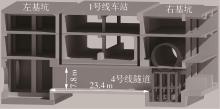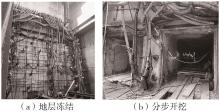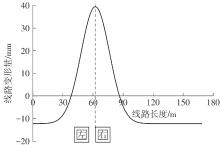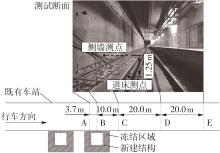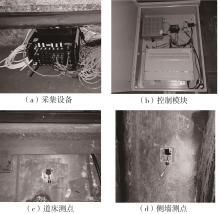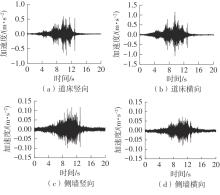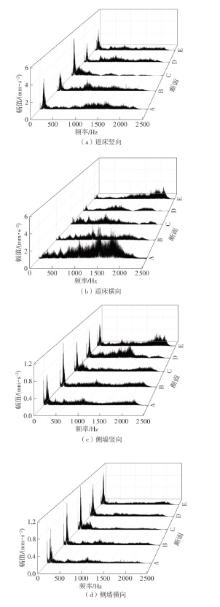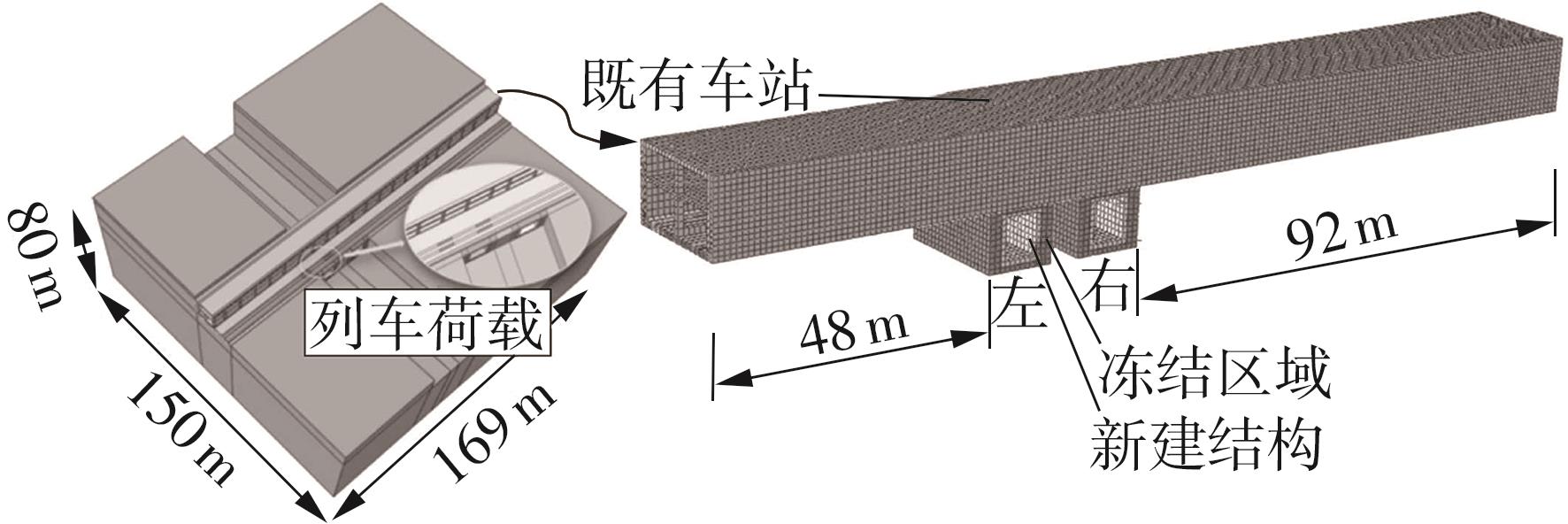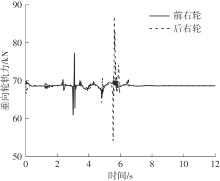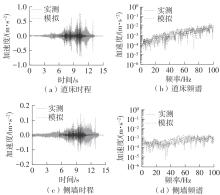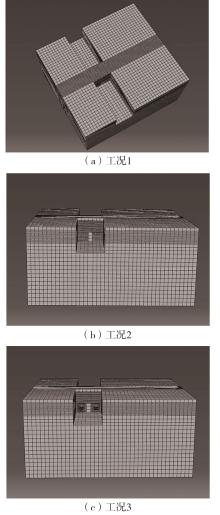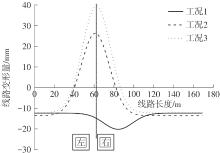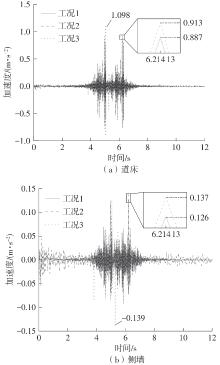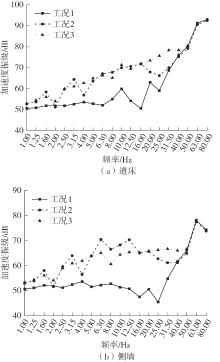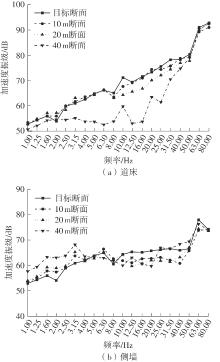Journal of South China University of Technology(Natural Science Edition) ›› 2025, Vol. 53 ›› Issue (7): 149-158.doi: 10.12141/j.issn.1000-565X.240421
• Architecture & Civil Engineering • Previous Articles
Evolution Analysis of Vibration Source Intensity of Subway Station Under the Influence of Closely-Spaced Undercrossing
CAO Yang, SHI Hao, LI Jiaofeng, TAO Jing
- College of Civil Engineering,Fuzhou University,Fuzhou 350108,Fujian,China
-
Received:2024-08-26Online:2025-07-25Published:2024-12-20 -
About author:曹洋(1985—),男,博士,副教授,主要从事轨道结构动力学及地铁运行环境振动研究。E-mail:hnyccy@163.com -
Supported by:the National Natural Science Foundation of China(51608127);the Natural Science Foundation of Fujian Province(2017J05078)
CLC Number:
Cite this article
CAO Yang, SHI Hao, LI Jiaofeng, TAO Jing. Evolution Analysis of Vibration Source Intensity of Subway Station Under the Influence of Closely-Spaced Undercrossing[J]. Journal of South China University of Technology(Natural Science Edition), 2025, 53(7): 149-158.
share this article
| [1] | 陶连金,刘春晓,许有俊,等 .密贴下穿地下工程研究现状及发展趋势[J].北京工业大学学报,2016,42(10):1482-1489. |
| TAO Lianjin, LIU Chunxiao, XU Youjun,et al .Research status and tendency of closely-attached intersecting underground structures[J].Journal of Beijing University of Technology,2016,42(10):1482-1489. | |
| [2] | 郭宏博,仇文革,牛晓宇,等 .新建通道密贴下穿地铁车站施工影响范围研究[J].土木工程学报,2021,54(S):113-120. |
| GUO Hongbo, QIU Wenge, NIU Xiaoyu,et al .Construction influence range of a new passageway closely undercrossing a subway station[J].China Civil Engineering Journal,2021,54(S):113-120. | |
| [3] | 张旭,张成平,韩凯航,等 .隧道下穿既有地铁车站施工结构沉降控制案例研究[J].岩土工程学报,2017,39(4):759-766. |
| ZHANG Xu, ZHANG Cheng-ping, HAN Kai-hang,et al .Case study of control technology of structural settlements due to tunnelling beneath a subway station[J].Chinese Journal of Geotechnical Engineering,2017,39(4):759-766. | |
| [4] | 杜文,王永红,李利,等 .双层车站密贴下穿既有隧道案例分析及隧道沉降变形特征[J].岩土力学,2019,40(7):2765-2773. |
| DU Wen, WANG Yonghong, LI Li,et al .Case study on double-deck subway station undercrossing and analysis of filed monitoring about this case[J].Rock and Soil Mechanics,2019,40(7):2765-2773. | |
| [5] | 杨子璇,姚爱军,张东,等 .隧道密贴下穿既有地铁车站沉降控制研究[J].地下空间与工程学报,2020,16(S1):442-449,464. |
| YANG Zixuan, YAO Aijun, ZHANG Dong,et al .Study on settlement control of tunnel closely passing through existing metro station[J].Chinese Journal of Underground Space and Engineering,2020,16(S1):442-449,464. | |
| [6] | 牛晓凯,张顶立,刘美麟,等 .新建地铁车站长距离密贴下穿既有隧道方案比选及实测变形分析[J].土木工程学报,2015,48(S1):270-274. |
| NIU Xiaokai, ZHANG Dingli, LIU Meilin,et al .Scheme comparison and measurement analysis of new-build subway station parallel under through existing tunnel in tight contact[J].China Civil Engineering Journal,2015,48(S1):270-274. | |
| [7] | 张振波,刘志春,郑凯,等 .PBA新建车站密贴下穿既有车站导洞施工工序优化研究[J].建筑结构,2020,50(S):882-887. |
| ZHANG Zhenbo, LIU Zhichun, ZHENG Kai,et al .Optimization construction process of PBA new station pilot tunnels under the existing station[J].Building Structure,2020,50(S):882-887. | |
| [8] | 田江涛,王海涛,周营,等 .新建车站密贴下穿既有车站施工方法研究[J].建筑结构,2022,52(S1):3119-3125. |
| TIAN Jiangtao, WANG Haitao, ZHOU Ying,et al .Research on the construction method of the newly-built station closely pasting and passing the existing station[J].Building Structure,2022,52(S1):3119-3125. | |
| [9] | LI X G, ZHANG C P, YUAN D J .An in-tunnel jacking above tunnel protection methodology for excavating a tunnel under a tunnel in service[J].Tunnelling and Underground Space Technology,2013,34:22-37. |
| [10] | 陶连金,安军海,边金,等 .密贴下穿地下工程施工新工艺“CRD+多重预顶撑”研究[J].湖南大学学报(自然科学版),2015,42(1):97-103. |
| TAO Lian-jin, AN Jun-hai, BIAN Jin,et al .Study on a new technology of“CRD+ multiple top bracing”applied in closely-attached intersecting underground structures[J].Journal of Hunan University (Natural Sciences),2015,42(1):97-103. | |
| [11] | 耿天霜,张静,赵记领,等 .南京地铁7号线中胜站密贴下穿运营站MJS+水平冻结施工与实测研究[J].隧道建设(中英文),2024,44(1):172-180. |
| GENG Tianshuang, ZHANG Jing, ZHAO Jiling,et al .Metro jet system and horizontal freezing construction at Zhongsheng station of Nanjing metro line 7 closely crossing underneath an operation station[J].Tunnel Construction,2024,44(1):172-180. | |
| [12] | 陶连金,王文沛,张波,等 .竖向强震作用下密贴地铁地下交叉结构动力响应分析[J].岩土工程学报,2012,34(3):433-437. |
| TAO Lian-jin, WANG Wen-pei, ZHANG Bo,et al .Dynamic response of closely-attached intersecting underground subway structures under vertical strong ground motion[J].Chinese Journal of Geotechnical Engineering,2012,34(3):433-437. | |
| [13] | 李积栋,陶连金,安军海,等 .近远场地震动作用密贴交叉组合地铁车站振动台试验[J].土木工程学报,2015,48(10):30-37. |
| LI Jidong, TAO Lianjin, AN Junhai,et al .Shaking table test of the closely-attached intersecting subway station under far-field and near-field ground motion[J].China Civil Engineering Journal,2015,48(10):30-37. | |
| [14] | 章慧健,牛晓宇,刘功宁,等 .既有地铁列车振动荷载下密贴下穿通道的动力响应特性研究[J].岩石力学与工程学报,2023,42(5):1273-1286. |
| ZHANG Huijian, NIU Xiaoyu, LIU Gongning,et al .Research on the dynamic response of the closely-attached underpass induced by the trains’ vibrating load of metro[J].Chinese Journal of Rock Mechanics and Engineering,2023,42(5):1273-1286. | |
| [15] | 于鹤然,周晓军 .高速列车动荷载作用下立体交叉铁路隧道动力响应研究[J].铁道学报,2015,37(6):103-111. |
| YU He-ran, ZHOU Xiao-jun .Study on dynamic response of grade-separated railway tunnels under high-speed train induced dynamic load[J].Journal of the China Railway Society,2015,37(6):103-111. | |
| [16] | 林志鹏 .列车荷载作用下重叠隧道结构动力响应分析[J].铁道科学与工程学报,2016,13(9):1789-1795. |
| LIN Zhipeng .Analysis on dynamic response of overlapped tunnel structure under vibration load[J].Journal of Railway Science and Engineering,2016,13(9):1789-1795. | |
| [17] | 王海龙,董捷,武志辉,等 .隧道近接施工对上部既有重载铁路隧道安全稳定性影响研究[J].铁道学报,2020,42(6):102-111. |
| WANG Hailong, DONG Jie, WU Zhihui,et al .Impact of undercrossing tunnel on safety and stability of exis-ting heavy-duty railway tunnel[J].Journal of the China Railway Society,2020,42(6):102-111. | |
| [18] | 朱正国,杨利海,王晓男 .交叉隧道耦合动荷载动力响应及安全分析[J].铁道工程学报,2018,35(3):63-68. |
| ZHU Zheng-guo, YANG Li-hai, WANG Xiao-nan. Analysis of dynamic response and security of crossing tunnel based on coupled dynamic load[J].Journal of Railway Engineering Society,2018,35(3):63-68. | |
| [19] | YAN Q X, CHEN H, CHEN W Y,et al .Vibration response and cumulative fatigue damage analysis of overlapped subway shield tunnels[J].Journal of Performance of Constructed Facilities,2020,34(2):04019121/1-15. |
| [20] | LI X H, LONG Y, JI C,et al .Study on the vibration effect on operation subway induced by blasting of an adjacent cross tunnel and the reducing vibration techniques[J].Journal of Vibroengineering,2013,15(3):1454-1462. |
| [21] | 晏启祥,王二力,张君臣,等 .列车荷载作用下联络横通道对平行交叉盾构隧道振动影响机制的试验研究[J].岩石力学与工程学报,2022,41(S1):2892-2900. |
| YAN Qixiang, WANG Erli, ZHANG Junchen,et al .Experimental study on the mechanism of the influence of transverse passage on vibration response of parallel cross shield tunnel under train load[J].Chinese Journal of Rock Mechanics and Engineering,2022,41(S1):2892-2900. | |
| [22] | 刘维宁,马蒙,刘卫丰,等 .我国城市轨道交通环境振动影响的研究现况[J].中国科学:技术科学,2016,46(6):547-559. |
| LIU Weining, MA Meng, LIU Weifeng,et al .Overview on current research of environmental vibration influence induced by urban mass transit in China[J].Scientia Sinica:Technologica,2016,46(6):547-559. | |
| [23] | 环境影响评价技术导则 城市轨道交通: [S]. |
| [24] | 翟婉明 .车辆-轨道耦合动力学[M].3版.北京:科学出版社,2007. |
| [25] | 梁波,罗红,孙常新 .高速铁路振动荷载的模拟研究[J].铁道学报,2006,28(4):89-94. |
| LIANG Bo, LUO Hong, SUN Changxin. Simulated study on vibration load of high speed railway[J].Journal of the China Railway Society,2006,28(4):89-94. |
| [1] | TIAN Sheng, XU Kai, ZHU Zekun, et al. Day-to-Day Evolution Model of Road-Network Mixed Traffic Flow in Autonomous Driving Environment [J]. Journal of South China University of Technology (Natural Science Edition), 2020, 48(4): 123-131. |
| [2] | Chen Hai-hui. Mechanism Design and Mechanics Model of the Platform Screen Doors for Subways [J]. Journal of South China University of Technology(Natural Science Edition), 2004, 32(4): 74-77. |
| Viewed | ||||||
|
Full text |
|
|||||
|
Abstract |
|
|||||
